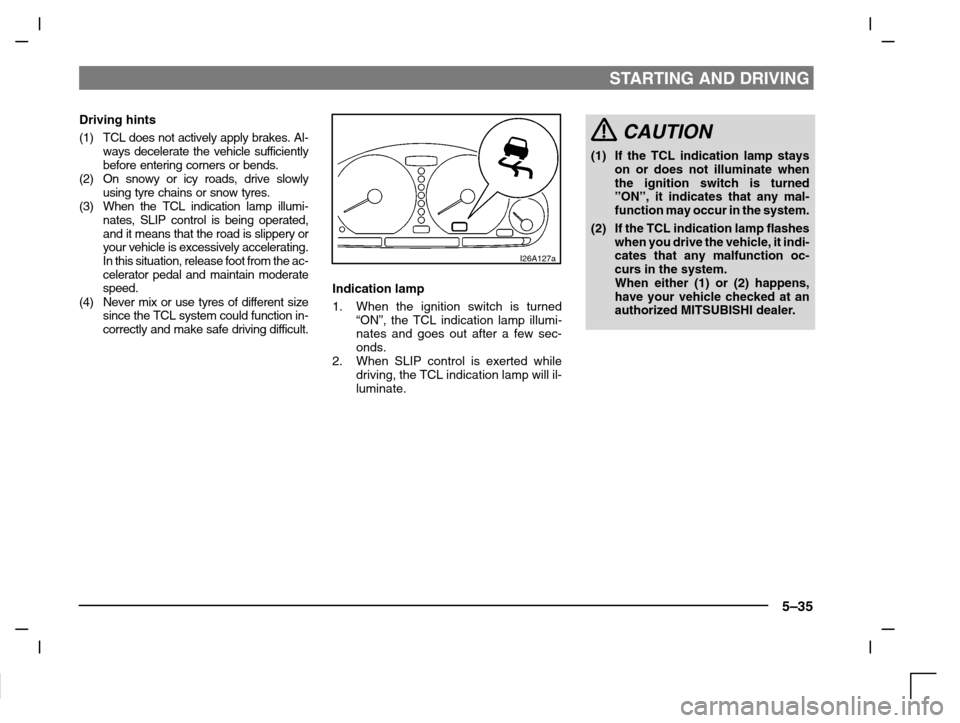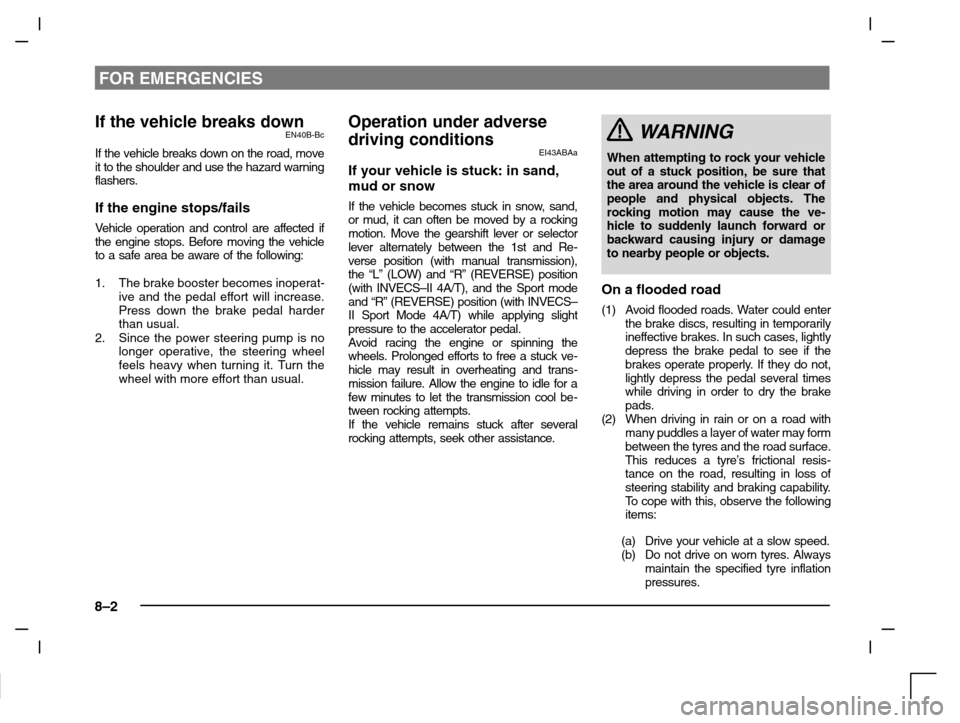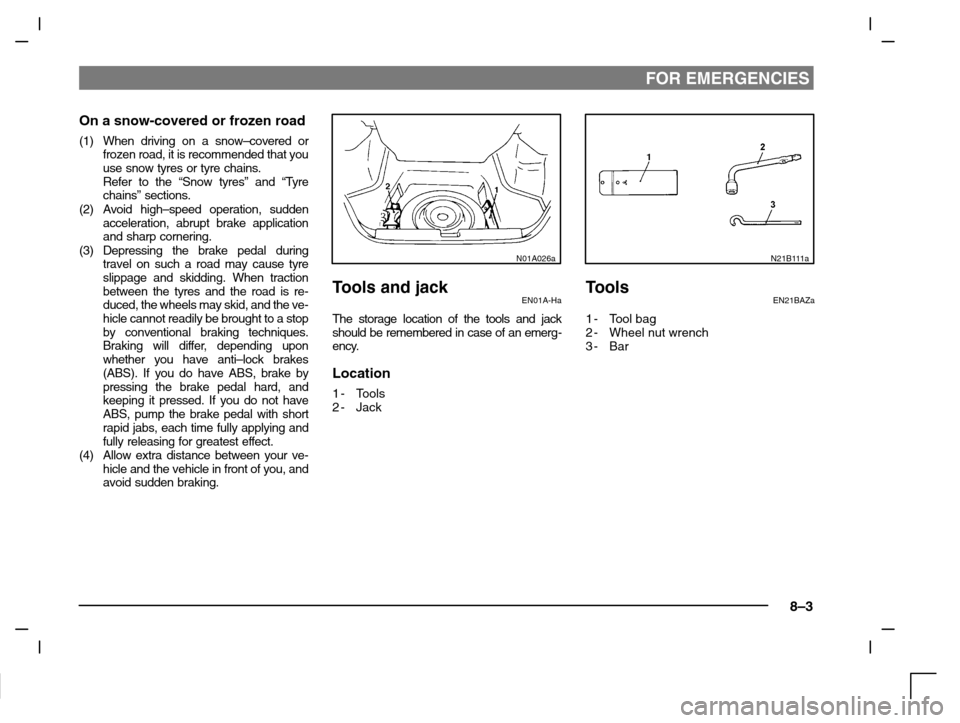Page 135 of 280

STARTING AND DRIVING
5–35
Driving hints
(1) TCL does not actively apply brakes. Al-
ways decelerate the vehicle sufficiently
before entering corners or bends.
(2) On snowy or icy roads, drive slowly
using tyre chains or snow tyres.
(3) When the TCL indication lamp illumi-
nates, SLIP control is being operated,
and it means that the road is slippery or
your vehicle is excessively accelerating.
In this situation, release foot from the ac-
celerator pedal and maintain moderate
speed.
(4) Never mix or use tyres of different size
since the TCL system could function in-
correctly and make safe driving difficult.
I26A127a
Indication lamp
1. When the ignition switch is turned
“ON”, the TCL indication lamp illumi-
nates and goes out after a few sec-
onds.
2. When SLIP control is exerted while
driving, the TCL indication lamp will il-
luminate.
CAUTION
(1) If the TCL indication lamp stays
on or does not illuminate when
the ignition switch is turned
”ON”, it indicates that any mal-
function may occur in the system.
(2) If the TCL indication lamp flashes
when you drive the vehicle, it indi-
cates that any malfunction oc-
curs in the system.
When either (1) or (2) happens,
have your vehicle checked at an
authorized MITSUBISHI dealer.
Page 202 of 280

FOR EMERGENCIES
8–2
If the vehicle breaks downEN40B-Bc
If the vehicle breaks down on the road, move
it to the shoulder and use the hazard warning
flashers.
If the engine stops/fails
Vehicle operation and control are affected if
the engine stops. Before moving the vehicle
to a safe area be aware of the following:
1. The brake booster becomes inoperat-
ive and the pedal effort will increase.
Press down the brake pedal harder
than usual.
2. Since the power steering pump is no
longer operative, the steering wheel
feels heavy when turning it. Turn the
wheel with more effort than usual.
Operation under adverse
driving conditions
EI43ABAa
If your vehicle is stuck: in sand,
mud or snow
If the vehicle becomes stuck in snow, sand,
or mud, it can often be moved by a rocking
motion. Move the gearshift lever or selector
lever alternately between the 1st and Re-
verse position (with manual transmission),
the “L” (LOW) and “R” (REVERSE) position
(with INVECS–II 4A/T), and the Sport mode
and “R” (REVERSE) position (with INVECS–
II Sport Mode 4A/T) while applying slight
pressure to the accelerator pedal.
Avoid racing the engine or spinning the
wheels. Prolonged efforts to free a stuck ve-
hicle may result in overheating and trans-
mission failure. Allow the engine to idle for a
few minutes to let the transmission cool be-
tween rocking attempts.
If the vehicle remains stuck after several
rocking attempts, seek other assistance.
WARNING
When attempting to rock your vehicle
out of a stuck position, be sure that
the area around the vehicle is clear of
people and physical objects. The
rocking motion may cause the ve-
hicle to suddenly launch forward or
backward causing injury or damage
to nearby people or objects.
On a flooded road
(1) Avoid flooded roads. Water could enter
the brake discs, resulting in temporarily
ineffective brakes. In such cases, lightly
depress the brake pedal to see if the
brakes operate properly. If they do not,
lightly depress the pedal several times
while driving in order to dry the brake
pads.
(2) When driving in rain or on a road with
many puddles a layer of water may form
between the tyres and the road surface.
This reduces a tyre’s frictional resis-
tance on the road, resulting in loss of
steering stability and braking capability.
To cope with this, observe the following
items:
(a) Drive your vehicle at a slow speed.
(b) Do not drive on worn tyres. Always
maintain the specified tyre inflation
pressures.
Page 203 of 280

FOR EMERGENCIES
8–3
On a snow-covered or frozen road
(1) When driving on a snow–covered or
frozen road, it is recommended that you
use snow tyres or tyre chains.
Refer to the “Snow tyres” and “Tyre
chains” sections.
(2) Avoid high–speed operation, sudden
acceleration, abrupt brake application
and sharp cornering.
(3) Depressing the brake pedal during
travel on such a road may cause tyre
slippage and skidding. When traction
between the tyres and the road is re-
duced, the wheels may skid, and the ve-
hicle cannot readily be brought to a stop
by conventional braking techniques.
Braking will differ, depending upon
whether you have anti–lock brakes
(ABS). If you do have ABS, brake by
pressing the brake pedal hard, and
keeping it pressed. If you do not have
ABS, pump the brake pedal with short
rapid jabs, each time fully applying and
fully releasing for greatest effect.
(4) Allow extra distance between your ve-
hicle and the vehicle in front of you, and
avoid sudden braking.
N01A026a
Tools and jackEN01A-Ha
The storage location of the tools and jack
should be remembered in case of an emerg-
ency.
Location
1-Tools
2-Jack
N21B111a
ToolsEN21BAZa
1- Tool bag
2-Wheel nut wrench
3-Bar
Page 214 of 280
FOR EMERGENCIES
8–14
WARNING
Avoid sudden braking, sudden accel-
eration and sharp turning; such op-
eration could cause damage to the
towing hooks or the tow rope.
People in the vicinity could be injured
as a result.
CAUTION
When going down a long slope, the
brakes may overheat, reducting ef-
fectiveness. Have your vehicle towed
on a trailer.
NOTE
(1) Be sure the towing speed is within the
legal limit. In addition, if the vehicle is
equipped with an automatic transmis-
sion, make sure that the towing speed
and distance given below are never
exceeded.
Towing speed: 50 km/h
To w i n g d i s tance: 30 km
(2) When the front tow hook is used, be
very careful so that the rope does not
cause damage to the body.
(3) To prevent entry of exhaust gas from the
towing vehicle, set the air selection lever
to the recirculation position.
(4) Your vehicle should only be used to tow
another vehicle if the weight of the other
vehicle is less than your vehicle.
N25A261g
Page 270 of 280
SPECIFICATIONS
10–12
Other specificationsEP01IMDb
ItemPetrol-powered vehicleDiesel powered vehicleItem1300, 16001800 (GDI)Diesel-powered vehicle
Fuel controlMulti-point injectionGasoline direct injectionInjectionFuel systemFuel pumpElectric motor typeElectric motor and
Mechanical single plunger typeCommon rail type
ClutchDry single disc clutch with diaphragm spring, hydraulic action
Steering systemRack and pinion type, power assisted
SuspensionFrontIndependent type, Mac Pherson sturt, coil springSuspensionRearIndependent type, multi-link, coil spring
TypeHydraulic, diagonally connected double circuit system with power assistance, anti-lock brake*
Service brakesFrontVentilated disc brakes
RearDisc brakes
Parking brakesParking brake acts mechanically on rear wheels
*: Option